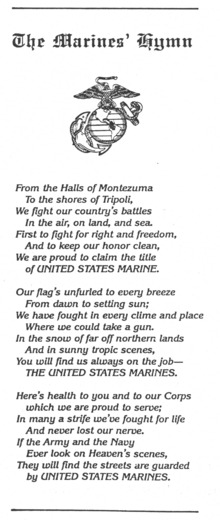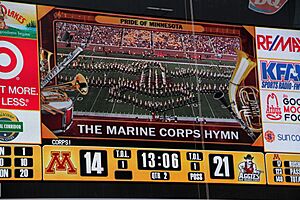Marines' Hymn facts for kids

Printed lyrics
|
|
| Organizational anthem of | the U.S. Marine Corps |
|---|---|
| Lyrics | Unknown |
| Music | Jacques Offenbach, 1867 |
| Adopted | 1929 |
The "Marines' Hymn" is the official song of the United States Marine Corps. It was introduced by Francesco Maria Scala, the first director of the USMC Band. The music comes from an 1867 work by Jacques Offenbach. The words were added later by someone whose name is not known. This hymn became official in 1929. It is the oldest official song in the United States Armed Forces. People usually sing the "Marines' Hymn" while standing at attention. This shows respect, much like when a national anthem is played. The third verse is also used as a toast at special events. These include the birthday ball and other ceremonies.
Contents
History of the Marines' Hymn
Some parts of the lyrics were popular sayings even before the song was written.
Meaning of the Lyrics
The line "To the shores of Tripoli" refers to the First Barbary War. This was a conflict in 1805. Marines fought in the Battle of Derna. After this battle, Lieutenant Presley O'Bannon and his Marines raised the American flag. It was the first time the flag was flown over the Old World. This phrase was then added to the flag of the United States Marine Corps.
"The Halls of Montezuma" refers to the Battle of Chapultepec. This battle happened on September 12-13, 1847. It was during the Mexican–American War. A group of Marines stormed Chapultepec Castle. The building was built by Spanish rulers, not by the Aztec Emperor Montezuma. At the time of the attack, it was the Mexican Military Academy.
The Blood Stripe Tradition
Marine Corps tradition says that the red stripe on their dress-blue trousers is special. This stripe is worn by officers and noncommissioned officers. It is known as the blood stripe. It honors the many Marine NCOs and officers who died. They were killed while storming Chapultepec Castle in September 1847.
The words of the hymn are thought to be from the 1800s. However, no written text from before the 1900s is known. The person who wrote the lyrics is also unknown. A legend says a Marine serving in Mexico wrote the hymn. The author changed the order of phrases from the Marine Corps motto. This made the first two lines of the hymn sound better. They read: "From the Halls of Montezuma, to the Shores of Tripoli." This put sound before the correct timeline of events.
Music Origin
The music for the hymn comes from a song called "Gendarmes' Duet." This song is from the 1867 version of the Jacques Offenbach opera Geneviève de Brabant. The opera first appeared in Paris in 1859. Colonel Albert S. McLemore and Walter F. Smith, who led the United States Marine Band, discussed the tune. Major Richard Wallach, USMC, said that in 1878, this song was very popular in Paris, France.
The name of the opera was shared with Smith. He confirmed that the music of the Marine Hymn was indeed from Genevieve de Brabant. He also noted that the melody was not exactly the same. One band member said his Spanish wife knew the tune from her childhood. This suggests it might have been a Spanish folk song. John Philip Sousa, a famous composer, also wrote about the hymn. He said the melody was from Offenbach's comic opera.
The lyrics also appear in a book called Rhymes of the Rookies. This book was published in 1917. The author of these poems was W. E. Christian. The book contains poems about military life before World War I.
Official Changes to the Hymn
Some websites, including the official USMC site, say the U.S. Marine Corps got a copyright for the song. This was either on August 19, 1891, or August 18, 1919. U.S. Copyright Law does not allow the government to copyright its own works. However, it can hold copyrights given to it by others. The Library of Congress says the song was first copyrighted in 1919 by The Leatherneck. This magazine was started by off-duty Marines in 1917. It used money donated by the YMCA. So, it might not be seen as a "work of the United States Government." Also, some composers have copyrights on their own versions of the song. These copyrights only cover their specific arrangements, not the whole song.
In 1929, the Commandant of the Marine Corps made the three verses of the Marines' Hymn official. They also changed some lines.
| Pre-1929 version | Authorized change |
|---|---|
| Admiration of the nation, we're the finest ever seen; And we glory in the title Of United States Marines. |
First to fight for right and freedom And to keep our honor clean; We are proud to claim the title Of United States Marine. |
You can hear this older version in the 1951 movie Halls of Montezuma. On November 21, 1942, Commandant Thomas Holcomb approved another change. The fourth line of the first verse changed from "On the land as on the sea" to "In the air, on land, and sea." This change showed that aviation was now a part of the Marine Corps.
Unique Use of the Hymn
Western Illinois University plays the hymn before all its football games. It is the only non-military school allowed to use the hymn. The university has had permission since 1927. They can use the official nickname, mascot, and hymn of the Corps.
Lyrics
From the Halls of Montezuma
To the shores of Tripoli;
We fight our country's battles
In the air, on land, and sea;
First to fight for right and freedom
And to keep our honor clean;
We are proud to claim the title
Of United States Marine.
Our flag's unfurled to every breeze
From dawn to setting sun;
We have fought in ev'ry clime and place
Where we could take a gun;
In the snow of far-off Northern lands
And in sunny tropic scenes;
You will find us always on the job
The United States Marines.
Here's health to you and to our Corps
Which we are proud to serve;
In many a strife we've fought for life
And never lost our nerve;
If the Army and the Navy
Ever look on Heaven's scenes;
They will find the streets are guarded
By United States Marines.
Extra Verses
Over the years, people have written unofficial extra verses. These verses remember later battles and actions. For example, U.S. military forces occupied Iceland in 1941. They guarded it against possible attack by Nazi Germany. After this, a new verse was written:
Again in nineteen forty-one, we sailed a north'ard course
And found beneath the midnight sun, the Viking and the Norse.
The Iceland girls were slim and fair, and fair the Iceland scenes,
And the Army found in landing there, the United States Marines.
See also
- "The Song of the Marines"
- Halls of Montezuma (film)
- To the Shores of Tripoli
- "The U.S. Air Force" (song)
- "Anchors Aweigh"
- "The Army Goes Rolling Along"
- Semper Paratus (march)
- Semper Supra (march)
- Sporting clubs that use the tune for their club songs:
- Australian Football
- Adelaide Football Club – "The Pride of South Australia"
- Perth Football Club
- Werribee Football Club
- Rugby League
- Melbourne Storm – "We are the Mighty Melbourne storm"
- Cantebury Bulldogs
- Australian Football


